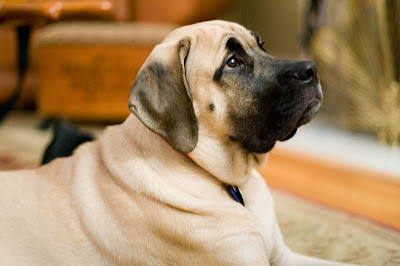Of all the known canine races the mastiff is the largest and eminently the most massive. Exceptional specimens of the St. Bernard, the boar-hound, and the Siberian blood-hound may exceed in height and weight the average of large mastiffs; but these examples are so rare as not to materially modify the assertion of the superiority of the proportions of the mastiff.
The distinguishing marks of this breed are size, massiveness, dignity, and majesty of appearance. Twenty-eight to thirty-one inches may be accepted as a good average height at the shoulders. The girth of the chest should never be less than one-third more than the height. The body should be long and well filled out, without any approach to the tucked-up loin of the hound. This is very objectionable. The legs should be straight, with immense bone and muscle; the feet round and close; the tail thick at the root, tapering evenly to a point, and not extending much below the hocks. The head is now the great point with fanciers. It should be broad across the skull, flat to the eyebrow, well indented up the center, with small, close-lying ears, partly erected when attention is aroused; the muzzle broad, short and square-looking, as though it had been sawed off. Fashion changes much in this direction. The great show dogs of ten years since would stand no chance in a modern competition. A very much shorter, blunter muzzle is now the standard. Whether the dog of to-day has really gained in appearance by his shorter muzzle is certainly open to doubt. The grand preeminent qualities of the mastiff are shown in his affectionate, true, noble, faithful disposition and even temper. He is above all others the watch-dog. Bred for generations for this purpose, his impulses lead him exclusively in this direction - to watch and guard, and to repulse trespassers within his precinct. He accomplishes this end by a resolute and imposing bearing, never resorting to force until repeated gentle warnings have been ignored. Menace to the person of his master the mastiff fiercely resents. His mode of attack is to spring upon an evil-doer, knock him down, and subdue him with significant growls. He seldom bites, even under the severest provocation. To guard those living in isolated localities, as a protector of women and children, he is without a peer - the sturdy and faithful watchman of the home. W. Wade "
With a massive body, broad skull and head of generally square appearance, it is the largest dog breed in terms of mass. Though the Irish Wolfhound and Great Dane are taller, they are not nearly as robust.
The body is large with great depth and breadth, especially between the forelegs, causing these to be set wide apart. The AKC standard height (per their website) for this breed is 30 inches (76 cm) at the shoulder for males and 27.5 inches (70 cm) (minimum) at the shoulder for females. A typical male can weigh 150–250 pounds (68–110 kg), a typical female can weigh 120–200 pounds (54–91 kg), with show specimens tending towards the upper ranges.
The Mastiff should at all stages of development show the breed characteristics of massiveness and sound, if cumbersome, movement.
The Mastiff is a particularly large dog demanding correct diet and exercise. Excessive running is not recommended for the first two years of the dog's life. However, regular exercise must be maintained throughout the dog's life in order to discourage slothful behavior and to prevent a number of health problems. A soft surface is recommended for the dog to sleep on in order to prevent the development of calluses, arthritis, and hygroma (an acute inflammatory swelling). Due to the breed's large size, puppies may potentially be smothered or crushed by the mother during nursing. A whelping box, along with careful monitoring can prevent such accidents. The average lifespan of the Mastiff is about 7 years although it's not uncommon for some to live to 10–11 years.
Data refer: http://en.wikipedia.org/wiki/English_Mastiff






